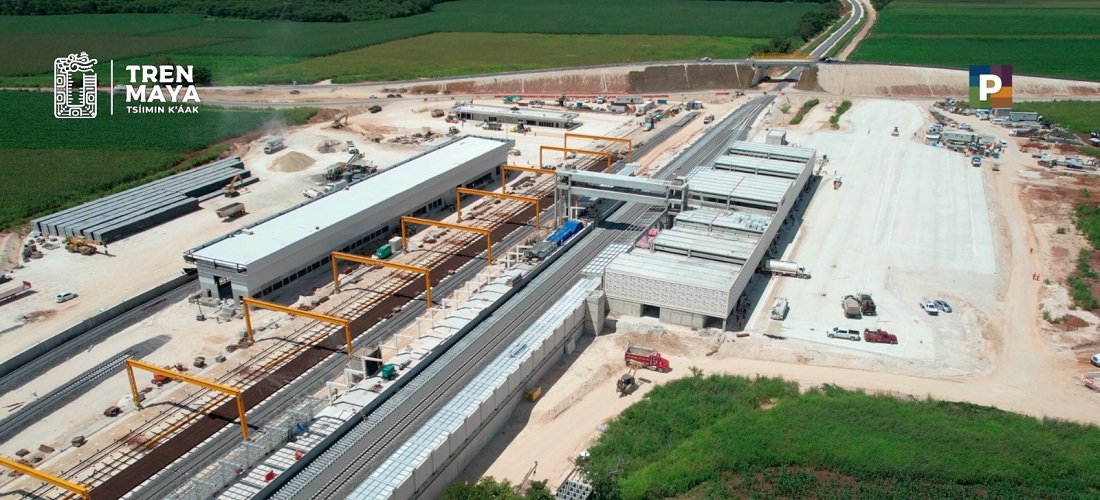
Mexico revives century-old railway in $2.8bn bid to rival Panama Canal
Oct, 17, 2023 Posted by Gabriel MalheirosWeek 202341
Mexico’s government is reviving a railway between the Gulf of Mexico and the Pacific Ocean that had been in decline for more than a century, in a bold bid to steal container traffic away from the Panama Canal.
The project seeks to capitalise on multinationals’ desire to be closer to the US and the canal’s periods of low water levels as the region suffers increasingly frequent droughts. For populist president Andrés Manuel López Obrador, it forms part of a gambit to draw investment to the poorer south — albeit one that industry figures are sceptical can succeed.
The $2.8bn Tehuantepec isthmus corridor will feature a 308km railway between renovated ports at Salina Cruz in Oaxaca state and Coatzacoalcos in Veracruz, and industrial parks close to transport hubs, including airports, along the route. Trains have already traversed the route on test runs ahead of its opening in December.
Mexico’s government is bullish about prospects for the rail crossing, which will offer proximity to the US and a transit time of 6.5 hours excluding loading time — less than the eight to 10 hours it takes on the 80km canal.
But experts said it could take years to build enough infrastructure and create the underlying industries to woo global logistics players, if that proves possible at all. And the added cost, time and insecurity in unloading containers on to a train with a fraction of a ship’s capacity, then back on to a vessel at Coatzacoalcos on the Gulf of Mexico, make it a tough sell, said logistics industry figures.
International shipping companies, freight groups and port terminal operators are yet to show interest in the route, they said, while the first round of industrial parks is set to attract mainly Mexican investment, according to the government. The corridor’s success would hinge on creating sustainable industries in the south of the country, they added.
“The day that our customers have decided to invest in manufacturing, that would drive demand potentially that could be interesting for us,” said Lars Østergaard Nielsen, head of Americas customer delivery at AP Møller-Maersk, the world’s second-largest container shipping group. If more manufacturing came south, the interoceanic corridor “could be very useful”, Nielsen said, adding that without that trend there would be “less demand” for the rail link.
Mexico had spent some 50bn pesos on the project, Buenrostro said, including on upgrading the railway, buying land for industrial parks and acquiring machinery and new rolling stock. Twelve mainly Mexican companies participated in the industrial park auctions, with 30 bids across five sites.
Building could begin next year and create 10,000 direct jobs, she said, adding: “We are very confident that these . . . parks will grow automatically.”
One of the worst droughts on record has hit the Panama Canal, which relies on huge freshwater volumes for its operation, this year. Its operators have restricted weight on crossings and for the first time reduced how many ships can cross each day to 31, from an average of 36.
Average waiting times for larger tankers carrying liquefied natural gas north through the canal rose as high as 20 days in August, up from a low of eight days during the same month in 2022, according to shipping agency Norton Lilly. Regular container traffic, which Mexico is trying to attract, has been less affected because its slots are booked further in advance.
Mexico’s government thinks the problems at the canal, which made $4.65bn in revenue last year, present an opportunity.
In its initial phase, the single-track rail line will run passenger and cargo trains simultaneously. The six cargo trains are capable of moving 260 TEUs — or 20-foot equivalent units, a measure of cargo capacity — on two journeys each a day, according to a government presentation.
That gives a maximum annual capacity of 1.14mn TEUs, which falls well short of the 10.9mn TEUs carried on container ships through the Panama Canal in 2022, according to data provider MDS Transmodal.
“A train isn’t the same as a ship. You have to consider the proportions. But given the changes we are seeing with climate change it’s a real and increasingly important alternative,” Buenrostro said of the Tehuantepec railway. A September presentation projected that 304,688 TEUs would move through the Isthmus corridor in 2028 and 1.3mn TEUs by 2036.
The canal’s director Ricaurte Vásquez Morales said the Mexican project could be a competitive threat were the canal to literally run out of water — but that was very unlikely.
“Definitely the Mexican solution could be a potential threat to the Panamanian operation,” he said at a recent news conference, adding that a replacement route would only be needed “if we were in a situation where there is no water at all, and we do not anticipate that”.
To mitigate the problems, Panama already offers road and rail transport across its isthmus, he said. The canal authority has also discussed a new reservoir project to provide fresh water.
López Obrador’s vision for the isthmus region is part of an ambitious resurrection of the country’s passenger railways, which mostly fell into disuse during the 20th century. The isthmus railway will eventually connect to López Obrador’s $30bn Mayan Train loop around the south, aimed at tourists, and an $18bn new oil refinery as he seeks to spread wealth via government mega-projects.
Source: Financial Times
Click here to access the original publication: https://www.ft.com/content/bbe8e851-e9f2-4ed1-a4a7-051a670b40e0
-
Trade Regulations
Mar, 23, 2023
0
Brazil investigates “dumping” in exports from China, Colombia and Peru
-
Ports and Terminals
Jul, 27, 2022
0
New crop boosts activities at the Port of Paranaguá
-
Ports and Terminals
Jun, 14, 2023
0
Producers look for cost-saving alternatives in the Port of Salvador
-
Economy
Nov, 03, 2023
0
ECLAC: Value of Exports in LAC Expected to Drop by 2% This Year

